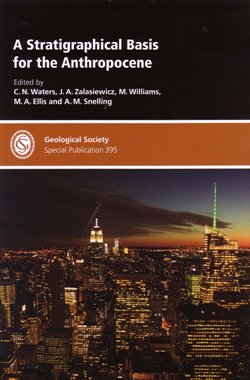 There is little doubt that human activity has drastically changed the face of the Earth, and this has led to the suggestion that we are now living in a new geological epoch - the Anthropocene.
There is little doubt that human activity has drastically changed the face of the Earth, and this has led to the suggestion that we are now living in a new geological epoch - the Anthropocene.
The Holocene was a time of gradual increase of humans and human influence, and the Anthropocene began with level of geologically-significant global change.
Anthropogenic changes to the lithosphere, biosphere, chemosphere, (and now 'technosphere') have overtaken the geological agents with which most of us are familiar. Humans have now overtaken nature as producers of minerals and sediments, outpacing sediment routing systems. Extinction is usually the result of competition and evolution, not overfishing; and artificial radionuclides obscure the classic volcanics for dating recent deposits.
With this new era of significant processes there is a need to move from an informal chronological concept to formally-defined stratigraphic unit, the Anthropocene, which needs a definition based on markers. This volume compiles evidence from a wide range of disciplines to help constrain the Anthropocene. In doing so it ambles deftly from formal stratigraphic definitions and discussion through to a wide range of indicators of anthropological activity which may be used to define the epoch.
In addition to discussing the familiar indicators of stratigraphic definition (ice, volcanic markers, geomagnetics, index fossils), the editors have given space to uniquely Anthropocene considerations from archaeology to anthropogenic radionuclides. The chapter 'Coral reefs in the Anthropocene' makes for a frank (albeit grim) assessment of reef decline but doesn’t necessarily contribute to the book’s overall objective of considering the stratigraphical basis for the epoch. However, the excellent speleology chapter 'Anthropocene viewed from the underworld' is a holistic appreciation of multiple markers and their interrelations.
Overall, the publication treats Anthropocene stratigraphy as more of a journey than a destination. Much discussion is given to marker methodology, but the basis for some of these markers for stratigraphy is often condensed into a few final paragraphs rather than being considered as an integral part. The reader is given substantial and fascinating instruction on decay of isotopes from nuclear weapons testing, but is left with more questions than answers about how to use these as a basis for stratigraphy. This is a shame, given the volume’s ambitious title. Given that the authors are such proponents of the Anthropocene (albeit with sensible caution) it is a shame the volume doesn’t quite 'go the final mile', from detailing the controversies and methodologies to suggesting their more concrete application to formal stratigraphy.
Reviewed by Nathan Allen
A STRAPHIGRAPHICAL BASIS FOR THE ANTHROPOCENE by C N WATERS, J A ZALASIEWICZ, M WILLIAMS, M A ELLIS & A M SNELLING 2014. GSL Special Publication #395; 321pp, hbk; ISBN 9781862396289. Geological Society Bookshop.